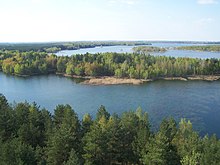Niemtsch opencast mine
The Niemtsch opencast mine was an open-cast lignite mine in the Lusatian lignite district, which was operated in the Cottbus district from 1940 to 1966 . It was in the Senftenberg district . By means of controlled flooding, it was converted into an artificial lake, the Senftenberger See , in the course of recultivation according to the ideas of landscape planner Otto Rindt .
geography
The opencast mine was located in Niederlausitz in the so-called Niederlausitz brown coal area.
The opencast mine was south of the city of Senftenberg . Neighboring the opencast mine are Niemtsch , Großkoschen , Kleinkoschen and Peickwitz .
history
In 1938 the opencast mine was opened. On April 23, 1940, the shaft wood laying and drainage began. The first coal was mined on May 6, 1941. The opencast mine was operated by Ilse Bergbau AG until April 20, 1945 . Due to the effects of the war, the power supply for the drainage system failed on that day. By June 22, 1945, the opencast mine, railway tracks and excavators were flooded by 4.5 million cubic meters of water. The water reached a height of 16 meters above the floor of the opencast mine.
On June 22, 1945, the pumping out of the water began, and in June 1947, the opencast mine started up again. The opencast mine belonged to the VEB lignite plant "Franz Mehring" Brieske. With order 118, the Soviet military administration ordered the construction of an overburden conveyor bridge. This began on March 10, 1949 the overburden extraction.
Coal was mined in one main and two secondary fields ( Elsterfeld and Südfeld ). In 1957 slides occurred near the Niemtsch mill , which buried the tracks. From May 26 to 27, 1959, a major fire in the opencast mine destroyed rails, overhead lines and pit tracks.
The last coal train left the mine on May 15, 1966. The overburden bridge was on 27 May 1966 to 11 30 blown PM.
After the end of coal production, the Senftenberger See, inaugurated on June 1, 1973, emerged as a post- mining landscape .
Lignite mining
From 1949 to 1966, 160 million tons of raw brown coal were mined. The brown coal seam was 5 to 10 meters thick. 400 million cubic meters of overburden were moved for the extraction.
Site and land use
1544 hectares of land were taken up by the open-cast mine, including the hammer mill Großkoschen and the Buchwalde airfield .
From 1955 to 1957, the bed of the Black Elster between Kleinkoschen and Brieske was relocated for the opencast mine over a distance of eight kilometers and placed in the bed of the Sornoer Elster flowing north . The trunk road 96 between Buchwalde and Großkoschen with 4.5 kilometers and the railway line Lübbenau – Kamenz on the Senftenberg – Hohenbocka section with a length of 7.5 kilometers were relocated.
literature
- Werner Forkert: Senftenberg retrospectives interesting facts from Senftenberg history . Bookstore "Glück Auf", Senftenberg 2006.
- Series of publications for local history research in the Senftenberg district no.3 . Senftenberg.
Web links
- Presentation of the Niemtsch opencast mine on ostkohle.de
Coordinates: 51 ° 30 ′ 29.2 ″ N , 14 ° 0 ′ 25.4 ″ E
